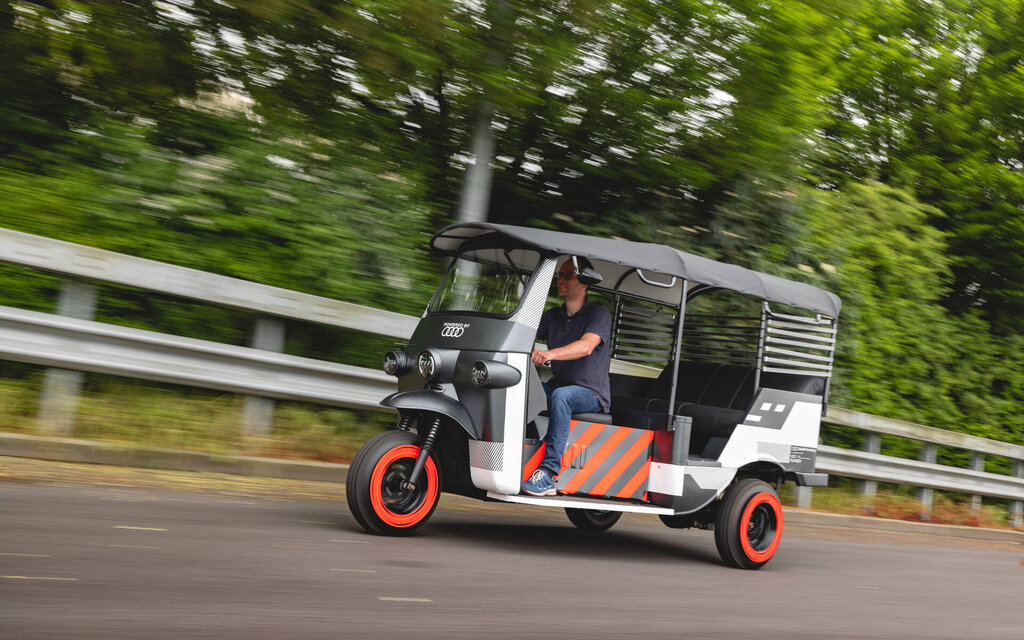I drive an electric vehicle at a speed varying between 30 and 50 km/h in the corridors of the Audi plant in Forest in Belgium, where the German brand’s Q8 and SQ8 e-tron electric SUVs are assembled. . My vehicle is not an SUV or a car, but rather a three-wheeled e-rickshaw designed and built by a team of trainees from Audi’s Neckarsulm factory in Germany.
With this e-rickshaw nicknamed “Gaia”, Audi is demonstrating in practice that it is possible to give a second life to battery modules that have previously been used in an electric vehicle. In addition, this e-rickshaw serves as a pilot project for theAudi Environmental Foundation who undertook to build it to help the community organization Nunam in India.
As we know, sales of electric vehicles are growing rapidly and the enthusiasm for this type of motorization is undeniable, particularly in Quebec. However, in the discourse surrounding electric mobility, there is rarely any question in the news of this concept of a second life for a battery whose condition no longer allows it to power an electric vehicle, after several years of use.
It’s even rarer to hear of the concept of providing some form of electric mobility for emerging markets, or those where access to mobility (petrol or electric) is prohibitively expensive for economic reasons. It was during a presentation on these issues that I discovered and drove the Audi e-rickshaw, and the pilot project run jointly by Audi and Nunam.
Photo: Audi AG
A 1979 rickshaw converted to electric
The Audi e-rickshaw is probably the most beautiful rickshaw on the planet with its black and silver paintwork as well as its build quality. However, it was initially a rickshaw built in 1979 which was powered by a very polluting gasoline engine. Audi trainees therefore removed it and replaced it with an air-cooled permanent magnet electric motor, which is powered by four battery modules with a total capacity of 6.4 kWh.
Power and torque values are 4.02 horsepower and 10.78 lb-ft respectively. As the e-rickshaw weighs 516 kilos, its time for the 0 to 45 km/h is 21.6 seconds… It is by a handlebar with accelerator control on the right handle, and a brake pedal on the right foot operating drum brakes, driving the Gaia e-rickshaw. The ground connections are ensured by a leaf suspension. The Gaia e-rickshaw demonstrates a beautiful duality with its design that is both very basic but also at the cutting edge of electric mobility technology!

Photo: Audi AG
This pilot project by Audi and Nunam will serve as the starting point for a gasoline rickshaw conversion program in India, which will provide mobility for community groups. Nunam has also developed a second pilot project in which batteries from electric vehicles are used to establish a solar nanogrid capable of powering around fifty kiosks and shops in the Uttar Pradesh region of India. This allows their owners to continue trading after dark, as this region is often affected by power outages.
BattMAN to the rescue
Audi has also developed the BattMAN software to analyze the state of health of the battery of an electric vehicle in a few minutes. Thus, it becomes possible to assess the condition of a battery for a second use, in whole or in part, in a new electric vehicle or its use as a mobile or static power source. In cases where the battery would be out of use, its components would be recycled to integrate them into a new battery.

Photo: Audi AG
THE Car guide also visited the Forest factory, the exclusive manufacturing site of the brand’s electric SUV since 2018, this vehicle then responding to the name of e-tron quattro. Since December 2022, the more sporty Q8 e-tron and SQ8 e-tron have been assembled in this carbon-neutral certified factory, from which more than 160,000 copies of Audi’s electric SUV have come out since the start of production. During 2023, this plant will produce the Q4 e-tron SUV.
Carbon neutrality
From 2025, all the brand’s factories will be carbon neutral, but the one in Forest was the first to achieve this milestone in 2018. To achieve this goal, it was equipped with a solar panel surface covering 107,000 square meters , which produces nearly 9,000 megawatts annually.

Photo: Audi AG
In addition, the transport of the electric motors of the Q8 e-tron and SQ8 e-tron, as well as the battery modules, is now done from Hungary to Belgium by rail, rather than by truck, which reduces emissions. of carbon of 2,600 tons per year. The Forest plant also recycles its gray water through a process that saves nearly 100,000 cubic liters of drinking water annually.
From 2026, Audi will only launch vehicles with electric motors on the world market, with the production of vehicles with internal combustion engines ceasing in 2033.
Starting next year, the manufacturer will begin production of the Q6 e-tron in Ingolstadt, in addition to inaugurating that of other electric vehicles at its factories in San José in the Chiapas region of Mexico as well as in Györ in Hungary. From 2029, all of the brand’s factories will produce at least one electric-powered model.
